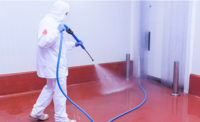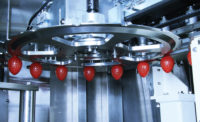
For those of us who started our career on the midnight shift in a dairy operation donning a rainsuit, rubber boots, goggles, a selection of chemicals, and a ready supply of water volume and pressure to aim at our objects, dry cleaning seems counterintuitive. Dry clean tools and methods must be learned; it is not the same as wet cleaning. In environments that were not originally designed for dry cleaning, the sanitation cycle may take longer until we can optimize.
Facility environments for the manufacture of infant formula, neutropenic or ready-to-eat foods can benefit greatly from hygienic design and practice that eliminates water from the environment. Keeping water out of the environment continuously enables environmental control of serious pathogenic organisms such as Salmonella and Cronobacter. If allowed to enter high-care environments, these organisms can survive without water for long periods of time.
Avoidance of water is an important method of control, as keeping a dry environment is a major deterrent to the outgrowth of the biofilms that these organisms occupy. Avoidance of water with aggressive chemicals also can be beneficial to the longevity of non-stainless plant fabric in processing and packaging environments.
Hygienic design considerations for dry-cleaned areas
Environments and processing/packaging equipment designed for dry products in a dry environment share many of the same designs as those in a wet cleaned high care environment. The foundation document 3-A Sanitary Standard for General Requirements, ANSI/3-A 00-01-2018, addresses the fundamentals of materials, design, fabrication, and installation of food processing equipment and processing systems. Along with these general criteria, standards for individual processing equipment are available at www.3-a.org to help assure good hygienic design and compliance with regulatory requirements.
Zoning to protect critical care and high-care environments (zones 1 and 2) is important to prevent the transfer of organisms from medium and low-care zones via footway, wheelway, and airborne vectors. A well-designed protective zoning plan based on a risk assessment should be developed through engagement of a cross-functional team consisting of engineering, quality, operations, and material handling. Newer Greenfield or Brownfield Investments should also have business representation to provide some direction on likely future products and processes.
Topline zoning elements include material transfers from low-care warehousing without wheelway exchanges between the low and medium-care and airlocks with material hand-offs going from medium-care to high-care areas. Personnel movement should be maintained within walkways separate from wheelways. Hygiene junctions should be utilized with shoe changes on top of a bench along with a change of outer clothing and handwash for personnel entry into high-care areas. Depending on the outcome of your risk assessment, personnel entry into medium-care areas from low-care areas may require an automated application of non-aqueous sanitizer spray to the soles of shoes or a walk through an EPA-registered powdered sanitizer to reduce microbial transfer.
Efficient dust collection systems for processing, transfer, storage, and packaging equipment must be part of the design. Keeping the near environments (environmental monitoring zones 1 and 2) free of fugitive dust is important to maintain sanitation and prevent dust from becoming a vector for movement of organisms. Plant air quality and gradient is important to separate the zones. Depending on the outcome of the risk assessment, the high-care environment should receive make-up air with a filter efficiency of 12 to 16 MERV or even HEPA.* Air pressure gradient should be highest at packaging and then step down through the operation to storage, drying operations, processing, warehousing.
Practices to follow in dry cleaned operations
“Beginning with the end in mind” is essential practice for dry product processing. Dry cleaning success is intentional. The team must be alert to small leaks and remedy any sources of fugitive dust during the production campaign. Clean as you go. Don’t wait until the end of a 30-day production cycle to start a cleaning cycle. Availability of HEPA-filtered vacuums that are zone specific are essential to maintenance of the environment during production. Do not use non-HEPA filtered vacuums as they will spew fine dust particles out of the exhaust potentially carrying microorganisms/allergens to redeposit in higher quality zones.
Validated allergen cleans can be more challenging with a dry clean process versus wet cleaning. However, with experimentation of tools, cleaning compounds and methods, validated clean breaks can be achieved. Some validated allergen cleans require the use of limited, controlled wet cleaning. This means bucket and brush application or single use towels to assist with the allergen (protein) soils removal. If limited wet (area) cleaning is required, the key to prevent risk of bacterial outgrowth is a rapid dry.
Be aware of all the tools that may be used for dry cleaning of dry products. Through experimentation, you will develop a Sanitation Standard Operating Procedure (SSOP) utilizing only the tools used in the validation of the process.
- Brooms, or controlled single use mop heads with non-aqueous alcohol with surfactants.
- Industrial roll single-use towels and electrostatic towels may be “wetted” with alcohol based cleaners.
- Scrapers.
- Resin-set brushes with soft tethered end bristles.
- HEPA filtered vacuums.
- SPACEVAC or 6061 aluminum vacuum extensions for overhead cleaning.
- Dry Ice or media blast (baking soda or salt): removed soils must be vacuumed.
- Dry Steam: great to restore equipment — slow for large areas.
- Pig systems: interior of piping.
- Hot oil: interior of piping, can be used to sanitize.
- Dry Ice abrasion inside of conveyors and equipment (non-blast).
- Portable sprayer systems with on board pump, Carbon dioxide propelled applicators or pump-up sprayer: used to sanitize with EPA registered alcohol-based sanitizers or other aerosolize-able sanitizer products.
- Heat can be used to sanitize small equipment. It is very difficult to achieve necessary time and temperature with large equipment.
The cleaning cycle for dry cleans has similar steps to a wet clean cycle. Steps are as follows:
- Pre-Sanitation preparation: remove all supplies and prepare to disassemble equipment. Hopefully you have not arrived at this point needing to pick up a lot of debris.
- Secure equipment: dismantle and practice log out, tag out (LOTO).
- Pre-clean: sStart at the top to “knock down” the heavy soils
- Detail cleaning: cleaning of hard-to-access (HTA) areas
- Post inspection and re-clean.
- Verification or pre-op by flashlight, SS mirror, ATP, or lateral flow device if allergen clean.
- Sanitize non-aqueous EPA-registered food contact surface sanitizer.
While dry cleaning does not advantage all dry operations equally, it is a highly effective practice to prevent and control outgrowth of environmental pathogens in high and critical care areas of our sensitive food operations.
*MERV rating is an abbreviation for Minimum Efficiency Reporting Value. A MERV rating tells you, on a scale of 1-16, how effectively your filter traps the small particles you don't want circulating through your area. The higher a MERV rating, the higher the amount of particles the filter traps.
HEPA stands for high efficiency particulate air filter. HEPA filters are used in many air purification applications to protect health and safety such as airplane cabins, hospitals, laboratories, etc. HEPA filters need to be able to trap the overwhelming majority of particles as small as 0.3 microns. One micron is equal to one 1,000th of a centimeter.




